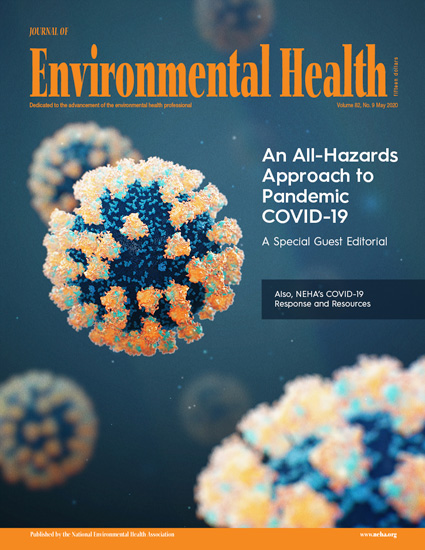Associations of dichlorophenol with metabolic syndrome based on multivariate-adjusted logistic regression: a U.S. nationwide population-based study 2003-2016
IF 5.3
2区 环境科学与生态学
Q1 ENVIRONMENTAL SCIENCES
引用次数: 0
Abstract
Para-dichlorobenzene (p-DCB) exposure associated with oxidative stress has indeed raised public concerns. However, whether p-DCB is linked with metabolic syndrome (MetS) remains unclear. We hypothesized that higher exposure to p-DCB would be linked with a higher risk of MetS in the U.S population. This study aimed to examine the associations of exposure to p-DCB with MetS prevalence. We included 10,428 participants (5,084 men and 5,344 women), aged ≥ 20 years, from the National Health and Nutrition Examination Survey (2003–2016). The cases of MetS were diagnosed by NCEP/ATPIII. Logistic regression models were conducted to calculate the odds ratios (ORs) and 95% confidence intervals (CIs) of MetS prevalence. Moreover, the mix associations of p-DCB metabolites were assessed using quantile sum (WQS) regression and quantile g-computation (qgcomp) methods. We documented 2,861 (27.1%) MetS cases. After adjustment for the potential risk factors, the ORs (95% CI) of MetS prevalence across the quartile of urinary 2,5-dichlorophenol (2,5-DCP) were 1.09 (0.93-1.28), 1.22 (1.00-1.49), and 1.34 (1.04-1.73). Moreover, 2,5 DCP is significantly associated with a higher prevalence of abdominal obesity [ORQ4vsQ1 (95% CI): 1.23 (1.03-1.48)]. The WQS and qgcomp index also showed significant associations between p-DCB metabolites and MetS. Moreover, we further examined that 2,5 DCP was correlated with higher systolic blood pressure (r = 0.022, P = 0.027), waist circumference (r = 0.099, P < 0.001), and glycohemoglobin (r = 0.027, P = 0.008) and a lower high density cholesterol (r = -0.059, P < 0.001). In addition, the significant positive associations between 2,5 DCP and MetS were robust in the subgroup and sensitivity analyses. These findings indicated that increased urinary p-DCB concentration, especially 2,5 DCP, had a higher MetS prevalence. These results should be interpreted cautiously and further research is warranted to validate our findings.基于多元调整逻辑回归的二氯苯酚与代谢综合征的关系:2003-2016 年美国全国人口研究
与氧化应激有关的对二氯苯(p-DCB)暴露确实引起了公众的关注。然而,对二氯苯是否与代谢综合征(MetS)有关仍不清楚。我们假设,在美国人口中,较高的对二氯苯暴露量与较高的 MetS 风险有关。本研究旨在探讨接触对二氯苯与 MetS 患病率之间的关系。我们纳入了全国健康与营养调查(2003-2016 年)中年龄≥ 20 岁的 10,428 名参与者(男性 5,084 人,女性 5,344 人)。MetS 病例由 NCEP/ATPIII 诊断。采用逻辑回归模型计算 MetS 患病率的几率比(ORs)和 95% 置信区间(CIs)。此外,还使用量子和(WQS)回归和量子 g 计算(qgcomp)方法评估了 p-DCB 代谢物的混合关联。我们记录了 2861 例(27.1%)MetS 病例。对潜在风险因素进行调整后,尿液中 2,5-二氯苯酚(2,5-DCP)四分位数的 MetS 患病率 ORs(95% CI)分别为 1.09(0.93-1.28)、1.22(1.00-1.49)和 1.34(1.04-1.73)。此外,2,5-二氯丙醇与较高的腹部肥胖症患病率明显相关[ORQ4vsQ1 (95% CI):1.23 (1.03-1.48)]。WQS 和 qgcomp 指数也显示 p-DCB 代谢物与 MetS 之间存在显著关联。此外,我们进一步研究发现,2,5 DCP 与较高的收缩压(r = 0.022,P = 0.027)、腰围(r = 0.099,P < 0.001)和糖化血红蛋白(r = 0.027,P = 0.008)以及较低的高密度胆固醇(r = -0.059,P < 0.001)相关。此外,在亚组分析和敏感性分析中,2,5 DCP 与 MetS 之间的显著正相关关系也很稳固。这些结果表明,尿液中 p-DCB 浓度升高,尤其是 2,5 DCP 浓度升高,会导致 MetS 患病率升高。对这些结果应谨慎解读,并需要进一步的研究来验证我们的发现。
本文章由计算机程序翻译,如有差异,请以英文原文为准。
求助全文
约1分钟内获得全文
求助全文
来源期刊

Environmental Health
环境科学-公共卫生、环境卫生与职业卫生
CiteScore
10.10
自引率
1.70%
发文量
115
审稿时长
3.0 months
期刊介绍:
Environmental Health publishes manuscripts on all aspects of environmental and occupational medicine and related studies in toxicology and epidemiology.
Environmental Health is aimed at scientists and practitioners in all areas of environmental science where human health and well-being are involved, either directly or indirectly. Environmental Health is a public health journal serving the public health community and scientists working on matters of public health interest and importance pertaining to the environment.
 求助内容:
求助内容: 应助结果提醒方式:
应助结果提醒方式:


